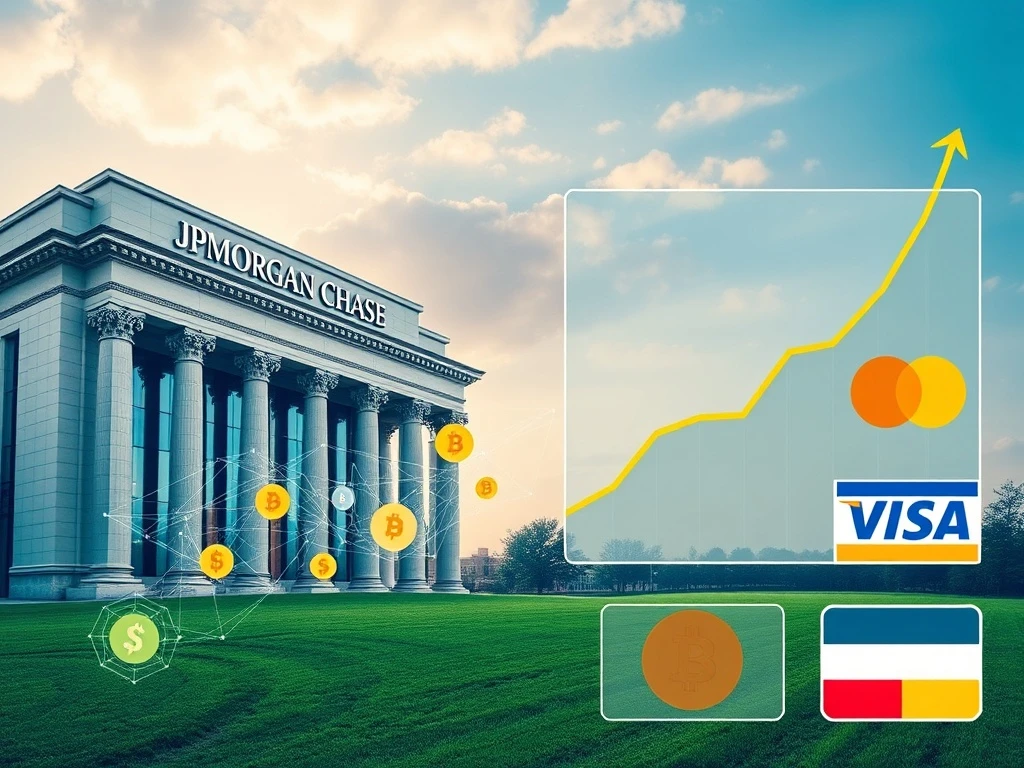JPMorgan’s Astounding Stablecoin Pivot: $27T Volume Redefines Traditional Finance

Are we witnessing a monumental shift in global finance? The financial world is buzzing with news that JPMorgan stablecoins are now at the forefront of the bank’s strategic vision, signaling a profound embrace of digital assets. This isn’t just about a bank dabbling in crypto; it’s about a titan of traditional finance recognizing the undeniable power and efficiency of blockchain-based stablecoins.
The JPMorgan Stablecoins Revolution: A $27 Trillion Shift
JPMorgan Chase, a cornerstone of the global financial system, recently announced a significant strategic pivot: the deep integration of stablecoins into its vast array of financial services. On July 15, 2025, the bank outlined its intent to leverage stablecoin technology to enhance cross-border transactions, streamline financial services, and expand its offerings in tokenized real-world assets. This isn’t a minor adjustment; it’s a foundational shift that could redefine how value moves across the globe.
This bold move by JPMorgan is not happening in a vacuum. It aligns with a broader, growing institutional interest in stablecoins, which have demonstrated remarkable utility and scalability. According to JPMorgan analysts, stablecoins processed an astonishing $27 trillion in transaction volume in 2024. To put that into perspective, this volume surpassed the combined processing volumes of financial giants Visa and Mastercard. This staggering figure underscores the burgeoning utility and adoption of stablecoins, moving them from niche crypto assets to mainstream financial instruments.
The firm highlighted stablecoins’ potential to significantly streamline operations in various critical areas:
- Remittances: Offering faster, cheaper ways for individuals to send money across borders.
- Trade Settlement: Expediting and reducing the cost of international trade transactions.
- Decentralized Finance (DeFi) Applications: Providing a robust and stable foundation for innovative financial products and services.
JPMorgan projects a potential $75 billion increase in stablecoin supply, a clear indication of their anticipated growth and importance. Jamie Dimon, CEO of JPMorgan Chase, emphasized the bank’s commitment to digital innovation, stating the initiative aims to “enhance our financial services and explore new opportunities within the cryptocurrency sector.” This statement alone signals a profound evolution in the bank’s stance on digital assets.
Unpacking the Monumental Stablecoin Volume
The sheer scale of stablecoin volume, reaching $27 trillion in 2024, is a game-changer. This figure isn’t just a statistic; it’s a testament to the efficiency, speed, and cost-effectiveness that stablecoins bring to financial transactions. Unlike volatile cryptocurrencies, stablecoins are pegged to stable assets like the U.S. dollar, making them ideal for everyday transactions and large-scale settlements without the price fluctuations.
Consider the implications of stablecoins outperforming Visa and Mastercard in transaction volume:
- Efficiency: Stablecoin transactions can settle in minutes, sometimes seconds, regardless of geographical boundaries or banking hours. Traditional systems often involve delays, especially for cross-border payments.
- Cost Reduction: Transaction fees for stablecoins are typically significantly lower than traditional banking fees, especially for international transfers.
- Accessibility: Stablecoins can be accessed and used by anyone with an internet connection, potentially broadening financial inclusion.
- Programmability: Being built on blockchain, stablecoins can be integrated into smart contracts, enabling automated and complex financial operations.
The bank’s analysis highlights stablecoins as a crucial bridge between digital and traditional markets. Their low-cost, instant transaction capabilities directly address long-standing inefficiencies in legacy financial systems. This performance validates the technology’s readiness for mainstream adoption and its potential to revolutionize global payments.
Bridging to Traditional Finance Crypto
The move by JPMorgan represents a critical step in integrating traditional finance crypto. Teresa Ho, a JPMorgan analyst, noted that stablecoins could become a cornerstone of traditional finance, particularly in collateralization and margin requirements for trading and lending. This perspective is vital because it shifts stablecoins from being merely a medium of exchange to a foundational asset within complex financial operations.
Emerging trends already show financial institutions experimenting with these integrations:
- Tokenized Deposits: Banks are exploring how to represent traditional deposits as tokens on a blockchain, enabling instant settlement and greater programmability.
- Stablecoin-Backed Loans: Using stablecoins as collateral for loans, offering new avenues for liquidity and credit in both digital and conventional systems.
This convergence means that the lines between what we consider ‘traditional’ and ‘digital’ finance are blurring. Stablecoins, with their stability and blockchain-native features, are perfectly positioned to facilitate this merger, providing the necessary infrastructure for a more efficient and interconnected global financial ecosystem.
The Future of Digital Asset Integration
The successful future of digital asset integration hinges significantly on regulatory developments. Recent legislation, such as the “Genius, Clarity, and Anti-CBDC acts,” aims to enable broader institutional participation in stablecoin activities. These legislative efforts indicate a growing recognition by governments of the need to provide clear guidelines for digital assets, fostering innovation while mitigating risks.
However, challenges persist on this path:
- Data Access Restrictions: Traditional financial institutions often face hurdles in accessing and utilizing data from blockchain networks due to regulatory or technical limitations.
- Compliance Hurdles: Adhering to existing anti-money laundering (AML) and know-your-customer (KYC) regulations within a decentralized framework can be complex.
- Interoperability: Ensuring seamless communication and transaction capabilities between different blockchain networks and traditional systems remains a technical challenge.
JPMorgan’s decision to suspend the onboarding of crypto platform Gemini highlights these tensions. Such incidents underscore the ongoing debates over regulatory clarity and access to banking data, illustrating the complexities that arise when traditional institutions interact with crypto operators. Despite these hurdles, the market response to JPMorgan’s analysis has been positive, with investors viewing the firm’s endorsement as validation of stablecoins’ utility and potential.
Unlocking Value with Tokenized Assets
JPMorgan’s strategic focus reflects a broader industry shift towards tokenized assets. By positioning stablecoins as both a medium of exchange and a collateral asset, the bank signals confidence in their ability to reduce costs and enhance efficiency in traditional financial workflows. This aligns with global efforts to tokenize a wide range of assets, from real estate to equities, streamlining ownership transfer and liquidity.
The journey towards full integration will require collaboration among regulators, banks, and crypto platforms to address technical and legal barriers. However, the trajectory is clear: tokenization is set to redefine global value transfer systems. Stablecoins are at the heart of this transformation, offering a stable, efficient, and compliant pathway for traditional finance to embrace the digital future.
JPMorgan’s strategic embrace of stablecoins is more than just a headline; it’s a clear signal that digital assets are not a fleeting trend but a fundamental component of the future financial landscape. The staggering $27 trillion in stablecoin transaction volume is a testament to their utility, efficiency, and growing adoption. As traditional financial giants like JPMorgan continue to integrate these powerful tools, we can expect a more efficient, accessible, and interconnected global economy, redefining how we interact with money and assets.
Frequently Asked Questions (FAQs)
Q1: What is the significance of JPMorgan’s pivot to stablecoins?
JPMorgan’s pivot signifies a major endorsement from a leading traditional financial institution for stablecoins and digital assets. It indicates that stablecoins are moving beyond the cryptocurrency niche and becoming integral to mainstream financial operations, particularly for cross-border transactions and tokenized asset offerings.
Q2: How did stablecoin transaction volume compare to Visa and Mastercard in 2024?
According to JPMorgan analysts, stablecoins processed an astounding $27 trillion in transaction volume in 2024, surpassing the combined processing volumes of Visa and Mastercard. This highlights the rapid growth and efficiency of stablecoin usage in global transactions.
Q3: What benefits do stablecoins offer to traditional financial systems?
Stablecoins offer several benefits, including low-cost and instant transaction capabilities, enhanced efficiency for cross-border remittances and trade settlement, and the potential to serve as collateral and margin in trading and lending. They act as a bridge between digital and traditional markets.
Q4: What are some challenges to integrating stablecoins into traditional finance?
Key challenges include navigating complex regulatory environments, addressing data access restrictions between traditional and blockchain systems, ensuring compliance with existing financial regulations (like AML/KYC), and achieving seamless interoperability between different platforms.
Q5: How do regulatory developments impact stablecoin adoption by institutions?
Regulatory developments, such as the “Genius, Clarity, and Anti-CBDC acts,” are crucial. They aim to provide legal frameworks that enable broader institutional participation in stablecoin activities. Clear regulations help build confidence and reduce legal uncertainties for banks and financial institutions.
Q6: What is the long-term outlook for tokenized assets in traditional finance?
The long-term outlook suggests a gradual but significant shift toward tokenization-driven markets. As institutions like JPMorgan champion stablecoins and tokenized assets, we can expect increased efficiency, reduced costs, and the redefinition of global value transfer systems through blockchain technology and digital assets.








